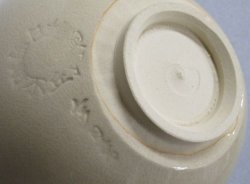Ishibashi-Seiyudo
「静友」という語は 北宋の詩人 黄庭堅(1045-1105)が作り
禅僧 一休宗純(1394-1481)が広めたとされる 「香十徳」の
「感格鬼神 清淨心身 能除汚穢 能覺睡眠 静中成友 塵裏偸閑 多而不厭 寡而為足 久蔵不朽 常用無障」
のうち 「静中成友」に因る。
筆は 裏千家13代家元 圓能斎鉄中宗室(1872-1924)。作年未詳。
The word "Seiyu" is derived from the Huang Tingjian‘s poetry “Ten Virtues of Kō”.
( Huang Tingjian 【1045–1105】 was a Chinese famous calligrapher, scholar, government official, and poet of the Northern Song Dynasty.)
“Ten Virtues of Kō” is said to Japanese great Zen monk, Ikkyu Sojun (known as “Ikkyu-san” 【1394-1481】) was spread in Japan.
The contens of “Ten Virtues of Kō” are as follows : “1,Sharpens the senses 2, Purifies the body and the spirit 3,Eliminates pollutants 4,Awakens the spirit 5,Heals loneliness 6,Calms in turbulent times 7,Is not unpleasant, even in abundance 8,Even in small amounts is sufficient 9, Does not break down after a very long time 10, A common use is not harmful” .
The meaning of "Seiyu" is applicable to "5,Heals loneliness".
This Shosoku Calligraphy has been written by Ennousai Tetchu 【URASENKE Sen Soshitsu XIII(1872-1924)】. Written Year unknown.
禅僧 一休宗純(1394-1481)が広めたとされる 「香十徳」の
「感格鬼神 清淨心身 能除汚穢 能覺睡眠 静中成友 塵裏偸閑 多而不厭 寡而為足 久蔵不朽 常用無障」
のうち 「静中成友」に因る。
筆は 裏千家13代家元 圓能斎鉄中宗室(1872-1924)。作年未詳。
The word "Seiyu" is derived from the Huang Tingjian‘s poetry “Ten Virtues of Kō”.
( Huang Tingjian 【1045–1105】 was a Chinese famous calligrapher, scholar, government official, and poet of the Northern Song Dynasty.)
“Ten Virtues of Kō” is said to Japanese great Zen monk, Ikkyu Sojun (known as “Ikkyu-san” 【1394-1481】) was spread in Japan.
The contens of “Ten Virtues of Kō” are as follows : “1,Sharpens the senses 2, Purifies the body and the spirit 3,Eliminates pollutants 4,Awakens the spirit 5,Heals loneliness 6,Calms in turbulent times 7,Is not unpleasant, even in abundance 8,Even in small amounts is sufficient 9, Does not break down after a very long time 10, A common use is not harmful” .
The meaning of "Seiyu" is applicable to "5,Heals loneliness".
This Shosoku Calligraphy has been written by Ennousai Tetchu 【URASENKE Sen Soshitsu XIII(1872-1924)】. Written Year unknown.

